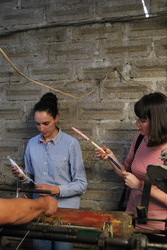|
We're very proud to present the fruits of almost a year of hard work in Mexico at Dutch Design Week from 18-26 October. A steadily growing group of craftsmen and women has been experimenting with recycling plastic bags, according to the technique developed with Precious Waste. This new resource, combined with their own specific skills has led to some beautiful samples and prototypes which we will show at two venues during Dutch Design Week. The samples we are showing now will form the basis of Anudando's first product line: Renacimiento (rebirth), coming out next year, so come have a look at what we have in store for you...
You can find us at Material Sense Lab and Fair Trade Design Skills. We're also featured in a special guide covering all socially sound and ecologically sustainable presentations during the DDW by Connecting the Dots and Stichting Doen with a very nice interview and a video (below). And of course check out our new site: www.anudando.com In Spanish, but an English version is in the making... For non Spanish speakers: consider this a teaser! Even though our spinning experiment in Gualupita didn't work as well as we'd hoped, the tip we got that day about the weekly meeting of the town's craftsmen proved very valuable. On a monday evening we went back to Gualupita, expecting to find maybe a few people at the crafts center, but when we got there the place was bustling with activity. Many women and a few men were there with their work (mostly knitting) and were discussing all the pieces that would be sold in the shop.
We quickly introduced ourselves to the lady who seemed to be in charge and she immediately called everyone to attention. The people fell silent as Raquel explained who we were, and why we were there. While she did the talking I passed around a few bobbins of plastic yarn and the textile I had woven with them. I've seen the astonished reactions of people when they realize the material they are looking at is actually made of plastic bags many times before, but here it was extra special because these were not any people, they were very experienced craftsmen and they were impressed. One man was immediately pointed out by te crowd, he was the one we should talk to. His name was Tito and he was one of the few remaining weavers in the town, but also the most inventive one. We had a really nice conversation with him and he was eager to learn more about the material. He invited us to come by and try out some of his self-built machines, so a couple of days later we returned to Gualupita with a good supply of cut plastic bags to see señor Tito at work. We were welcomed by him and his wife into their home, which was also the workshop. A large weaving loom took up a third of the living room and a slightly smaller one occupied most of the bedroom. Besides that he had a knitting machine and different self-made machines for spinning yarns and winding bobbins standing around the place. We tried the different machines for spinning and this time with much better results than with the large wool twining machine we tried before. One of the machines needed a little bit of tweaking to work optimally with plastic, but señor Tito was happy to work on some adjustments. When he's made the modifications, he is going to try to spin a larger volume of yarns for us and test them out on one of his weaving looms, so we'll go back for that soon. It was great to meet and work with such a fantastic weaver/inventor especially because he seemed just as exited about this new experiment as we are.
In the town of Gualupita there used to be a blooming textile industry. In the nineteen thirties, one family invested in a range of large machines for spinning wool, to supply the local textile workshops with the yarns that were in high demand. Since then a lot has changed, the textile industry has all but disappeared from Gualupita and the machines that have been in possession of the same family for three generations are now used no more than once or twice a week.
The current owner was very curious about our samples of plastic yarn spun on a spinning wheel and spent an afternoon with us experimenting with our material on his twining machine. The machine could make around 160 bobbins of yarn at the same time, but since so far we're only making samples, we used two bobbins for our experiments and helped the spinner prepare the other bobbins to twine the wool he normally works with. This turned out t be a bit of a problem, because our plastic threads are much more fine and smooth than wool. The machine was perfectly adapted to thick wool but did not have enough tension for our thin material to spin well. Although the two bobbins of yarn we made look really nice, they are not of sufficient quality for us to work with. It's a pity the old machine doesn't work for us, it would have been great to give it a new purpose, but fortunately the spinner told us that most craftsmen that still remain in the village (mostly knitters) own spinning wheels. They use them not to spin yarns, but to wind yarns that are already spun, and they might be able to work with our material without too many changes. They meet once a week, and we are invited to their next meeting to see if someone would like to collaborate.
|
For an occasional newsletter
|
- Bureau Baggerman - Eindhoven - The Netherlands - info[at]bureaubaggerman.nl -









